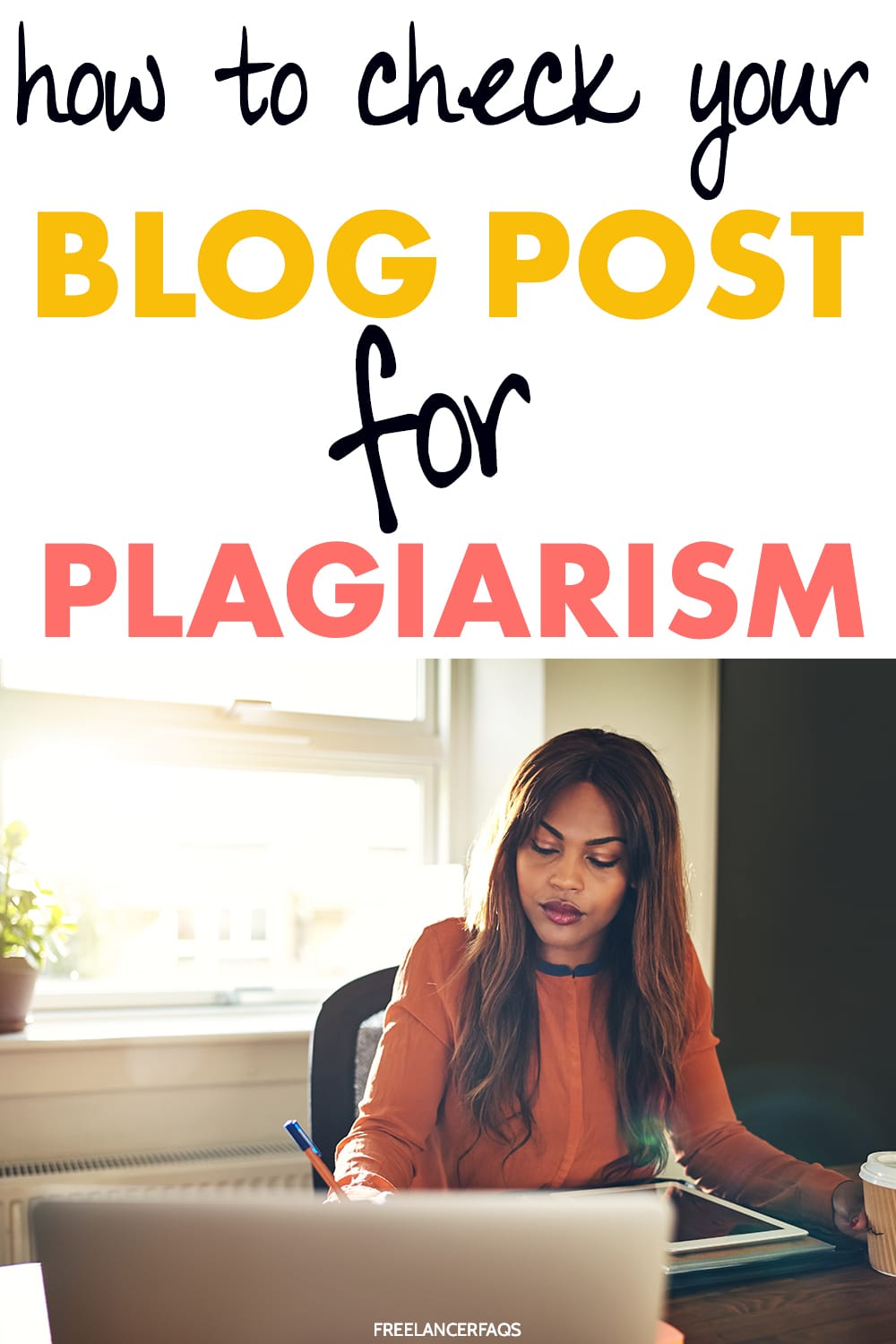Are you new to the freelance writing world and want to make sure you’re safe when it comes to online plagiarism?
There’s a fine line when it comes to online plagiarism, and you need to be familiar with the rules so that you can feel confident knowing that you’re not breaking any laws.

There’s a fine line when it comes to online plagiarism and you need to be familiar with the rules so that you can feel confident knowing that you’re not breaking any laws.
With so much content online, from podcasts to videos to blog posts and articles, how can you be sure that what you are writing is unique, authentic and not someone else’s writing?
In this post, I will go into what is plagiarism, how to avoid plagiarism and the steps you need to take each time you write content online to ensure your article is free of plagiarism.
What is Plagiarism?
The definition of plagiarism is,
“[A]n act or instance of using or closely imitating the language and thoughts of another author without authorization and the representation of that author’s work as one’s own, as by not crediting the original author.”
As straightforward as this definition might be, there’s a lot of grey area that plagues all freelancers when it comes to online plagiarism.
Have you ever innocently completed a task over and over again, just to find out later that you were doing it wrong all along?
This is exactly what I’m trying to help you avoid when you’re writing pieces online.
We’ll go over some common ways freelancers might plagiarize without even knowing it and also things you can do today to feel confident that you’re doing what you can to avoid online plagiarism in your next blog post.
Why Should I Avoid Plagiarism?

Online plagiarism and copyright infringement can not only be detrimental to your freelance writing career but can also ruin your client’s reputation.
Content creators don’t like to be copied without being sourced or receiving attribution, so be careful not to get yourself in that situation as there could very well be legal repercussions.
How Can I Write a Post or Article Without Plagiarism?
The bottom line is you will be reviewing other blog posts to do your research; this is one of the recommended steps in online research. Most of the blog posts you find will be similar, and it’s okay to use them as ideas to formulate your content.
Of course, this is an intimidating subject; no one wants to hear that they’re copying someone else’s work, and no one wants to be copied.
To help protect your reputation, keep the following tips in mind when writing your next client piece.
1. Be Yourself, Be Unique
It’s important as a writer to be authentic and unique in your writing and your ideas.
Of course, this is hard!
This is where your creativity and life experiences come in. Everything has been written online at some point, but how can you make it your own to stand out?
Is it a funny story that you can plug in at the beginning of your content, or is it a negative personal experience that your readers can learn from?
Think of something that will help you engage and relate to your readers and build off of that.
If you’re writing about diets and a healthy lifestyle, you can explain what you do and what works for you. Every reader likes to know more about the writer behind the words, so be yourself!
2. Use More than One Credible Source
When researching your content ideas, choose more than one source to support the idea for your article. Look for credible and reliable sources that have written about the subject.
A credible online source is current and is from a highly reputable business in the industry you’re writing about.
But be careful, you must repurpose their idea and put your spin on it! Skim over the blog posts so that their ideas do not influence you.
Look at the types of posts others are writing and come up with your style. The more you write, the easier this will be.
So how will you know if a source is popular and authoritative?
Similar Web is a website you can use to get information about a source.
Similar Web will show you details about website traffic, which will help you decide whether it’s a source worth using.
3. Provide Attribution for Ideas When Paraphrasing
When writing your online content, you may refer to someone else’s idea.
As stated above, it’s best to use your unique content, but it does happen from time to time that we’re influenced by the sources we read.
This is why it’s important to skim sources instead of reading them thoroughly so that you’re not influenced.
Even if you find yourself re-stating the idea in your own words, it’s best to provide attribution to the source of the idea to ensure you’re avoiding online plagiarism.
4. Cite and Quote Your Sources
This is probably the most obvious tip of them all, and it goes without saying that all writers must cite their resources, whether it be using a footnote or directly in the text itself.
This is the most important key to avoiding online plagiarism as you have to show your readers that you’ve done proper research on the subject.
When in doubt, cite the source.
You may get clients who think you’ve over cited, and that’s okay. They may delete some of your citations, but at least you’ve done your due diligence and showed where you got the information in your article.
Remember, your reputation is everything; once you’ve ruined it, it’s hard to get it back. So if you’re not sure, don’t be afraid to ask a professional for a second opinion.
Common Knowledge Sources
It’s essential to cite your sources, but you don’t need to cite statements that are considered common knowledge. But what is deemed to be common knowledge?
Common knowledge is “information that an average educated reader would accept without needing the validation of a source reference.”
For example, when citing statistics and quotes, you should always use a citation. By using a citation, readers can verify the information that you’ve provided.
Common knowledge is “widely known, undisputed and easily verified.” Average readers widely know common knowledge.
It can be found on many different sources online and is not the specific work of anyone. For example, you wouldn’t cite the fact that there are 365 days in a year as it’s common knowledge.
If you’re doubting whether or not the information is considered common knowledge, you can apply this test by asking yourself three questions.
If you’re still not sure, it’s best to cite the information to avoid online plagiarism.
5. Use Proper Images
 Remember the days when we used to pull images right off of Google, site the source, and that was the end of it?
Remember the days when we used to pull images right off of Google, site the source, and that was the end of it?
Well, those days are long gone– this would now be considered online plagiarism.
If you want to use a photo directly from Google, you have to find out who the owner is and ask them for permission to use that photo in your piece.
It seems like a lot of work, doesn’t it?
Well, here’s a couple of easier ideas to find images for your clients.
Use Creative Commons (Zero) Images
Use Creative Commons (Zero) stock images in your client pieces.
You can use them for free without attributing or citing the source, although it is recommended that you give the photographer attribution.
We all want credit for our work, right? So, why not!
But where can you find these images? You can use the following sites entirely for free:
- Pexels
- Pixabay
- Barn Images
- Unsplash
Create Your Own Graphics
If you’re looking for something a little more unique and directly related to your post, you can create your graphics using stock photos in Canva.
This will ensure that your content is unique and highly engaging.
6. Use a Plagiarism Checking Tool
It’s also in your best interest to finish your client pieces off by running them through a plagiarism checker just as you would check your grammar and sentence structure. You can use the following two free tools to check for online plagiarism:
- Grammarly
- Copy Leaks
- Copyscape
Key Takeaways
Although online plagiarism can be scary, if you have the proper tools and are aware of it, you have nothing to worry about!
When writing your client pieces, be sure to keep your content as unique as possible while citing and quoting sources and providing attribution when necessary.
Be sure to stay protected by using images and graphics that you’ve created on your own or that you’ve gotten from a Creative Commons Zero site.
Then, finish off your client piece by checking for grammar, sentence structure, and running it through a plagiarism checker.
By keeping all of these tips in mind, you will be well on your way to writing professionally online while protecting your reputation.
Remember, if you’re unsure, it’s always wise to speak to a professional, or, to keep it simple, cite the source.
Do you feel better now that you’ve read this post?
If there’s still something that’s causing you to worry about online plagiarism, comment below with your question so that we can put your worries to rest!



Leave a Reply